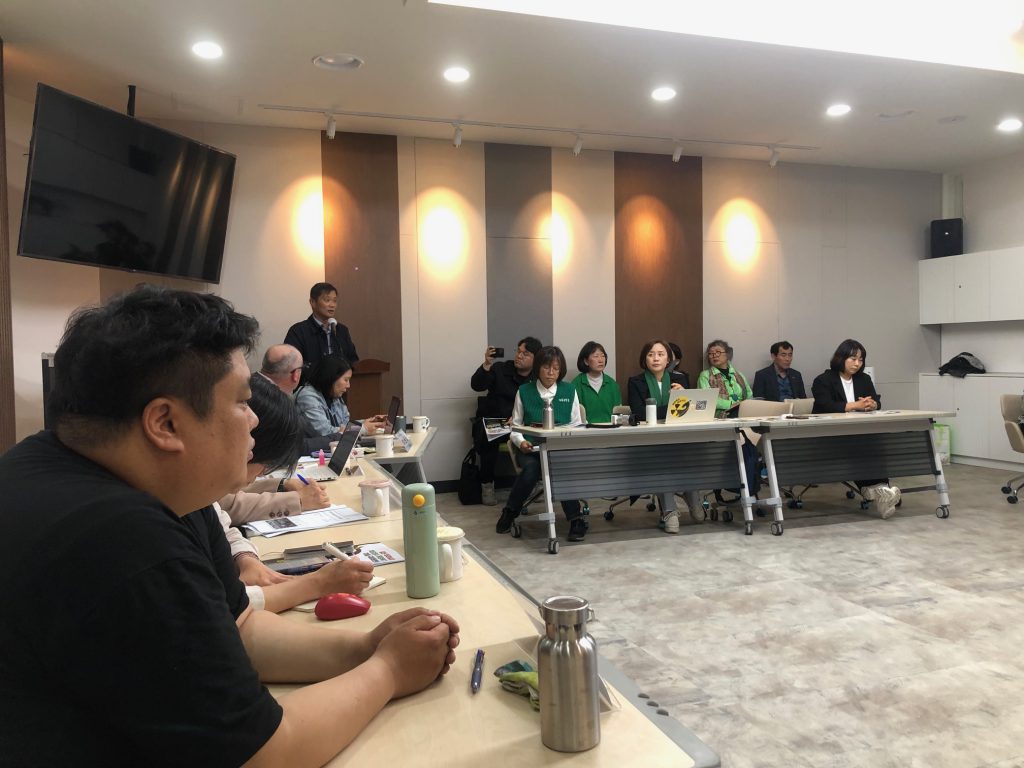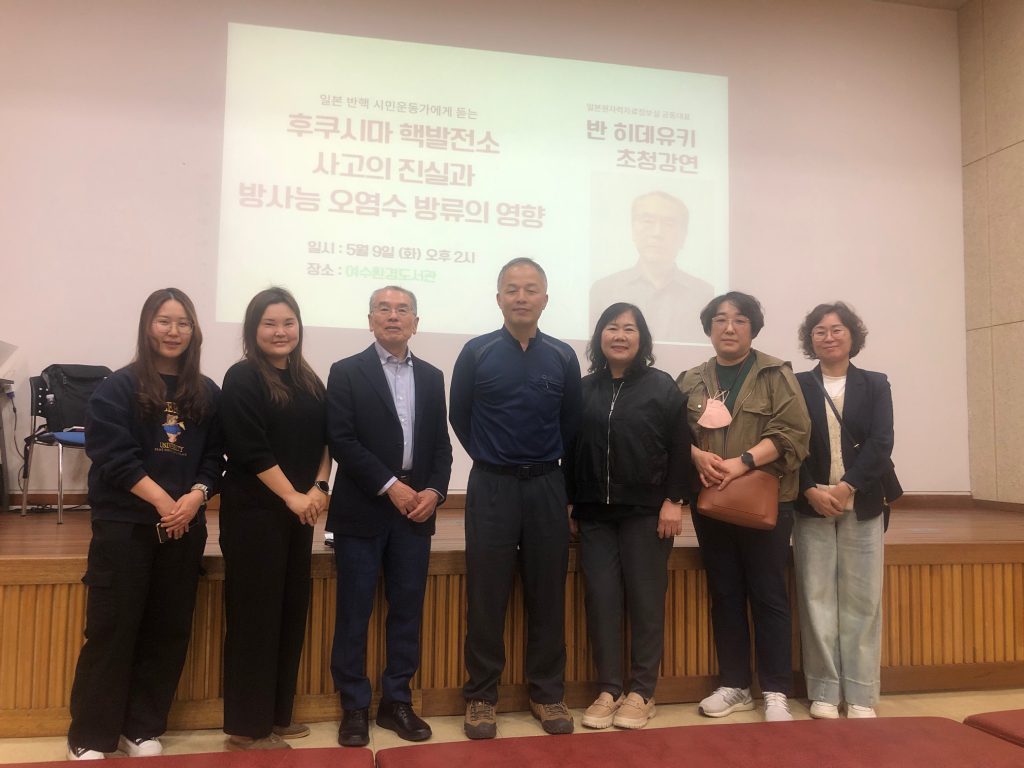Harsh criticisms and strong opposition to discharging contaminated water from Fukushima Daiichi into the ocean~ Report on visit to South Korea
By Hideyuki Ban (CNIC Co-Director)
I was invited to visit South Korea from May 8-10 and asked to give lectures on the projected release of the treated radioactive water from the Fukushima Daiichi Nuclear Power Station (FDNPS) into the ocean. This time, I visited three places, Jeju Island, Yeosu City and Seoul, and gave four lectures in total.
The first lecture was in Jeju. The lecture meeting was held in the conference room of the Jeju Special Autonomous Province Council. It was organized by the Joint Committee of the Six Korean Opposition Parties for Preventing discharge of Contaminated Water from Fukushima Daiichi into the Ocean, the Jeju branch offices of the Korean Federation for Environmental Movement (KFEM) and the Jeju and Yeosu branches of the YWCA. In this event, two guests gave lectures, myself and Mr. Shaun Burnie, representing Greenpeace International Asia. Mr. Burnie’s lecture focused on the danger of tritium contained in the treated waste water. I thus talked mainly about 1) the Fukushima fishermen’s strong opposition to the release of the water, 2) the fact that the plant operator is not allowed to discharge the contaminated waste water into the ocean without obtaining consent from the local fishermen, and 3) the prospect that this plan may result in discharging not only tritium but also 30 other kinds of radioactive nuclides* into the ocean for more than 30 years. After explaining about these topics, I talked about a possible alternative plan, which is mortar solidification of the radioactive substances.
Ms. Jang Hana, a member of Mothers Promoting Participation in Politics insisted that the discharge of the radioactive waste water into the ocean is violating the International Convention of the Sea. She asserted that the Korean government should file a suit against the operator of the Japanese nuclear plant. The reason why she maintained this was that Article 194 of the United Nations Convention on the Law of the Sea calls on all signatories “to take, as appropriate, all measures consistent with this Convention that are necessary to prevent, reduce and control pollution of the marine environment from any source, using for this purpose the best practicable means at their disposal and in accordance with their capabilities.”
Mr. Kim Jeongdo, Secretary-General of the Jeju KFEM, said he wrote a letter of protest against Japan’s decision to discharge the treated radioactive water into the ocean, and took the letter to the Japanese Consulate in South Korea, but they refused to accept it. He said he was shocked by their refusal. The provincial governor stated that this would be the right time to file a written complaint against Japan’s ocean release plan because Japan has yet to commence the discharge of the contaminated water into the ocean.
We then moved from the Jeju Special Autonomous Province Council to a separate building and talked with local women divers, known as ama in Japan. In the coastal areas of South Korea, there are many professional women who dive in the sea without any breathing equipment and collect shellfish and seaweed. They looked very healthy and aggressive. They all spoke strongly, saying they would not be able to make a living if the radioactive waste water is discharged from the nuclear plant into the ocean. When the organizers invited the divers to participate in their campaign against the ocean release plan earlier, the women not only agreed to participate but urged the organizations’ members to put more direct pressure on their leaders to force them to take a more aggressive stance.
The next place I visited was Yeosu City. I gave a lecture in the Yeosu City Environmental Library. This city is famous for fishing, but a big chemical plant is located there and the water pollution from the plant is allegedly causing health problems, just as in the case of Minamata disease in Japan. In Minamata, on the southern island of Kyushu, many residents suffered from mercury poisoning caused by a big chemical plant. Because the two cities are experiencing similar problems, the Yeosu citizens have had exchanges with the Minamata Disease Center Soshisha.
The Yeosu lecture meeting was organized by six organizations, YWCA, I Consumers’ Cooperative, and KFEM. Mr. Kim Young-Chul, Executive Chairman of the Korean National Federation of Fisheries Cooperatives also attended. He told the participants that the fishermen in the coastal areas from Busan to Yeosu are strongly opposed to the Japanese nuclear plant’s plan to release contaminated water into the ocean.
I was the only lecturer in the meeting. I talked about the discharge plan by referring to the possible health hazards of tritium. My lecture was a short one, taking about one hour, including interpretation from Japanese to Korean.
On May 10, the lecture meeting was held in the National Assembly Members’ Hall in Seoul. Three people gave lectures, including Mr. Shaun Burnie and Mr. Arjun Makhijani, the president of the Institute for Energy and Environmental Research (IEER), based in the US. Among the organizers of this event were the Democratic Party (DP), the Justice Party (JP), the Progressive Party (PP), and a citizens’ group protesting the dumping of Fukushima’s radioactive water into the ocean.
Just as with similar Japanese events, the first speakers were the Korean lawmakers, followed firstly by Mr. Makhijani, and concluding with my presentation.
Mr. Makhijani pointed out in his lecture that the contaminated water about to be released from the Japanese nuclear plant, may reach the coastal areas of the Asian continent and the Pacific island nations. He then said the water may be diluted and the amount of radioactivity contained in the water may become very small, but for the people living in such areas, the arrival of the radioactive waste water will bring no benefit to them. On the contrary, they may suffer damage. I was deeply impressed by this comment.
In all the lecture meetings, I received the same question, “Why is the Japanese government trying to force this discharge of radioactive water into the ocean despite strong opposition from local residents? I was stuck for an answer. The only answer that I could think of was that the government and the Tokyo Electric Power Co. (TEPCO) had promised the Fukushima prefectural government that the radioactive substances that should be removed from the nuclear power plant in the decommissioning process would be delivered to somewhere outside Fukushima prefecture, but the reality is that it is impossible for them to keep this promise.
*TEPCO originally claimed that there were 64 types of radionuclide contained in the contaminated water, but in TEPCO’s Radiological Environmental Impact Assessment (REIA) it states that the water contains 30 kinds of radionuclide other than tritium. This figure takes into account radionuclides with short half-lives which would have decayed by the time of the water release. However, there have been no independent checks on the contents of the tanks or whether it was appropriate to exclude the short-half life radionuclides.



